Martha Hall Kelly's Blog: Martha's Blog, page 15
April 5, 2016
Lilac Girls is Finally Here! Celebrated the Day Touring Caroline’s NYC.
Can’t believe the day has finally arrived. Lilac Girls is officially on sale and to mark the occasion, my daughter Mary and I spent the day retracing Caroline Ferriday’s footsteps in New York. The Waldorf Hotel’s Peacock Bar, St. Thomas Church, The Plaza Hotel and, of course, her work home, Le Maison Française at Rockefeller Center. Didn’t get to the top of the RCA building or the Rainbow Room, but maybe next time.

We tried to hit as many spots on the map below (hand-painted by the amazing Holly Hollon) as we could- what a fun way to spend the day in New York. Feel free to do the same when you’re in town- such a great way to see New York City.
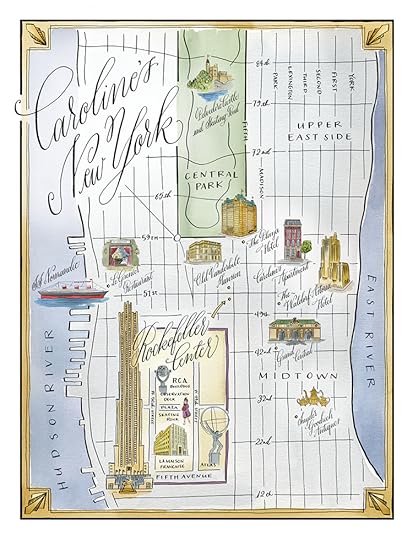
April 1, 2016
Pinch me. Lilac Girls is in People Magazine.
I was doing laundry yesterday afternoon when my friend and hair color wizard Jamie Latiolais called me. “Guess who’s in People Magazine,” he said. “You. And thank God your hair looks good.” An early April fools joke?
It still doesn’t seem real. The Donald adjusting his tie on the cover. The wonderful review. (Lilac Girls illuminates!)
 Seeing it nestled there in The Best New Books between two fascinating-looking non-fiction releases, Peggy Orenstein’s Girls & Sex and John Elder Robison’s Switched On was just so much fun.
Seeing it nestled there in The Best New Books between two fascinating-looking non-fiction releases, Peggy Orenstein’s Girls & Sex and John Elder Robison’s Switched On was just so much fun.

My friend Kristi and I jumped up and down in my kitchen as we read the review, then paged through the issue drawn into the glitzy People world. Happy birthday to Pharrell Williams. Taylor Swift’s red hot romance. Cate Blanchett in silver Roger Vivier heels. 96 pages of what’s happening in the world and Hollywood escape.
Everyone at Ballantine went crazy with congratulations and then I had to put down the lovely People world, back to the writer’s life. Back to folding laundry, but feeling just a little more glamorous.
March 30, 2016
Irene Tomaszewski, co-author of Code Name Zegota: Rescuing Jews in Occupied Poland, Shares the Story Behind this Incredible Book

Of all the books I read while researching Lilac Girls Code Name: Zegota by Irene Tomaszewski and Tecia Werbowski was one of the most helpful. It is a fascinating look into Zegota, a little-known underground movement, which operated during WWII in Poland. It inspired much of my character Kasia’s clandestine life in Lilac Girls and I recommend it highly.
Here are a few questions about the book Irene was gracious enough to answer:
When I first started researching Lilac Girls I read your book Code Name: Zegota: Rescusing Jews in Occupied Poland, 1942-1945 and was surprised to learn there was such a large, well-organized council to aid Jews in Poland. For those who are not familiar with Zegota can you explain how it started?
This is a tall order and I do recommend reading the book. But I will try to answer your question, though the answers must be brief.
At first, aid to Jews was primarily initiated by individuals helping Jewish friends or former colleagues. Children found wandering on their own were taken in, fed and placed privately or in institutions. Many of the people helping were also in the Polish underground resistance so they could obtain some help from that organization. Doctors, nurses and social workers were cooperating as well.
By 1942, the Warsaw ghetto was being liquidated and it was clear that help had to be better coordinated, though still in utmost secrecy. Some of the people already involved in helping, and in working with the underground, created Zegota which, by the way, is just a family name so it could be mentioned without arousing suspicion.
Day to day, how did Zegota operatives, help thwart the Nazis in Poland?
They helped Jews, especially Jewish children, out of the ghetto; they found them shelter either with Polish non-Jewish families or, if they could “pass” as Poles, i.e. they spoke good enough Polish and did not look or act like Orthodox Jews – Zegota supplied them with forged documents to substantiate their false identity, and got them work and the documents to go with that. Children were placed either with Polish families or in Catholic or state-run orphanages. Children also had to be supplied with false documents because the Gestapo frequently checked orphanages. For this reason, the children had to be taught how to behave like the other children, they had to learn prayers and other information in case a German officer questioned them, and to never talk about their real identity. This was extremely stressful fort the Jewish children, but also for everyone involved since if caught, all of them would have been executed.
Zegota also did everything possible to get news of the situation of the Jews during the German occupation to the outside world since Poland was completely surrounded either by Nazi Germany or the Soviet Union.
Zegota members escorted Jews in need of shelter to their new homes to help them control their fear and thus give themselves away.
Most important was providing funds. Since Poles were restricted to strict and very small rations and Jews were not entitled to any, extra food had to be obtained on the black market, a dangerous and costly business.
What was the role of Girl Guides in Zegota?
Many high school and university girls served Zegota, and the underground resistance in general, as couriers. This was very dangerous work and many young women were caught, sent to prison for interrogation, and then sent to concentration camps (including Ravensbruck), or executed.
You and Tecia Werbowski co-wrote Code Name: Zegota. How did you become interested in the subject?
We are both Polish, Tecia Jewish and I Christian. Tecia’s life was saved by Zegota people and when we met, I was just then researching this unknown story. We decided to do the book together.
How large was the Polish underground and why was it so much more extensive than those in other countries?
Poland had been partitioned between Russia and Germany earlier in its history so when the same thing happened in 1939 – many forget that Hitler and Stalin were allies for 20 months from September 1939 until June 1941 – and civilians were targeted from the start, Poles were well aware that this would be a terrible war. They had a long history of resistance to both German and Russian oppression and this new form with Nazi Germany and communist Russia, was a matter of survival.
Can you tell us about SWIT, the Polish secret radio station?
SWIT was a radio station that broadcast from London, although it identified itself as a station in Poland. The Germans spent years looking for it in Poland but, of course, could not find it since it wasn’t there. SWIT was such a well-kept secret that very few Poles knew its location. The underground got news to SWIT by a vast network of couriers and had a network of mobile radio transmitters in the country to transmit news to London as well.
How did Zegota discover what was happening inside concentration camps and get the word out to the West?
The underground, especially those involved with Zegota, kept steady contact with representatives of the Jewish community. One Courier, Jan Karski, delivered an eye witness report about the Warsaw ghetto and a transit camp for Jews being take to death camps. He did so with the aid of Jewish leaders and was given the mission of delivering this news to leaders in the West, among them Churchill and Roosevelt. One young courier who helped Karski was subsequently arrested and sent to Ravensbruck. I recommend an excellent new documentary, Karski and the Lords of Humanity.
Why did the world not listen to their reports?
Officially, because the war itself was the priority. But also, it seems, the plight of people far away and unseen did not seem very important to world leaders.
In Zegota you write about The Eagle Pharmacy. Can you tell us a bit about it? I found that story very moving.
This pharmacy was located in the district the Germans enclosed as a ghetto in Krakow. For some reason the Germans allowed it to remain there, even though it was owned by non-Jewish Poles. It was an oasis of peace in a place of terror, and provided a psychological lift for everyone who entered it. An amazing story, well worth a film.
Many years after the war Wladyslaw Bartoszewski, one of Zegota’s founders, said “The only people who can say they did enough to help the Jews were those who died for them.” Can you mention a few cases of those who gave their lives to help Jews in Poland?
There were a great many, including entire families from babies to grandparents. The most famous today is the Ulma family whose name is given to a new museum dedicated to Poles who saved Jews.
What did you learn while writing Zegota that surprised you most?
The entire story is so fascinating that it’s hard to pick just a few things. But certainly I was struck by the fact that this extraordinary story was simply unknown. We knew that under the communist regime, Moscow simply did not allow anything good to be said or written about Poland because they wanted to discredit it, suppress information about Soviet collaboration with Hitler, and justify its post-war control of the country. But here in the West? Maybe it’s because there was no happy ending for these brave people so recognizing them would mean acknowledging that Poland, the most loyal ally against Hitler, was ultimately betrayed. But the stories are finally coming out and they are breathtaking.
Thank you so much, Irene, for this wonderful inside look at Zegota. Lilac Girls readers will find it a good resource for the true story behind the novel.
This is the link to the book on Amazon.
March 26, 2016
Are You In NYC on April 6th? Join Us at the Lilac Girls Launch Party at the Corner Bookstore.
So excited the Lilac Girls launch party is finally happening and at The Corner Bookstore, such a comfy, charming place. The perfect spot to share the book with everyone. Please come celebrate with us if you’re in town!


March 25, 2016
The Lilac Girls Audiobook Just Landed
Wonderful Random House packages keep showing up on my doorstep, this one bearing the Lilac Girls Books on Tape audiobook. It’s gorgeous, packed in a sleek gray case, the perfect little sister to the hardcover.
 I popped the first CD into my desktop and started listening to the incredible Cassandra Campbell read Chapter One. A lovely, surreal moment. Can’t wait to hear the other two narrators, Kathleen Gati (of General Hospital fame) who plays the Polish character Kasia and Kathrin Hana who plays Herta.
I popped the first CD into my desktop and started listening to the incredible Cassandra Campbell read Chapter One. A lovely, surreal moment. Can’t wait to hear the other two narrators, Kathleen Gati (of General Hospital fame) who plays the Polish character Kasia and Kathrin Hana who plays Herta.
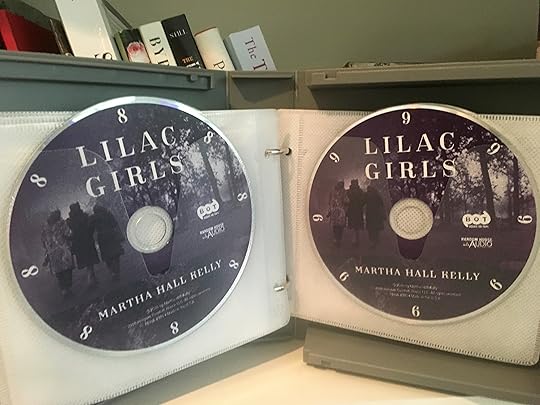
The cover says it is 17 1/2 hours long…my husband and I are going to settle in tonight and listen. Hard to believe this is actually happening. It will be available the same day as the hardcover and ebook–April 5th.

Only part I’m nervous about is “The note read by the author.” It’s always a bit weird to hear yourself…
March 16, 2016
Check out the cover of the Polish version of LILAC GIRLS.
 Love the cover for the version of Lilac Girls soon to be published in Poland. They did such a beautiful job. In case you don’t speak Polish, loosely translated, the subhead means: Story about the women connected by the nightmare of Ravensbruck. Great way to put it!
Love the cover for the version of Lilac Girls soon to be published in Poland. They did such a beautiful job. In case you don’t speak Polish, loosely translated, the subhead means: Story about the women connected by the nightmare of Ravensbruck. Great way to put it!
March 10, 2016
The first copies of Lilac Girls are finally here!

The package from my editor at Ballantine, Kara Cesare, sat on the counter for a while, waiting for my husband to come home.

But then opening it was so much fun. Surprise, there were two!

We read Kara’s lovely note and then all the best parts of the book–Mike saw the dedication and loved it, and then we just sat and stared at it. Such a beautiful book! The lettering shines, which is such a lovely detail. The deckle edge…
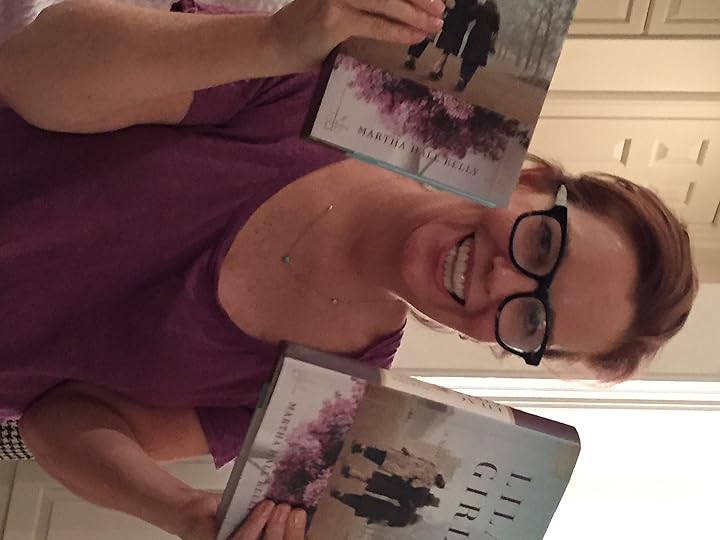
Home on the bookshelf at last.

Can’t wait for readers to have it in their hands. Ballantine did an amazing job.
February 26, 2016
Another Five Minutes With Jen Winner: American Housewife

Five Minutes with Jen, the podcast brought to us by Jen Dayton and Marianne Paterniti of the Darien Library has become my new go-to for what to read. Their charming, frank take on the latest books is refreshing and they haven’t steered me wrong yet. That’s where I found Helen Ellis’ American Housewife–a fabulous compilation of short stories so funny and unexpected I already want to go back and re-read them. Here in Atlanta where spring comes early it seems to be taking forever and this little book has gone far in keeping me smiling and somewhat sane, waiting for warmer weather. Well worth a read!
February 25, 2016
Which Star Rocked the Red Carpet in These Long Lost Photos I Took at the 1995 Oscars?
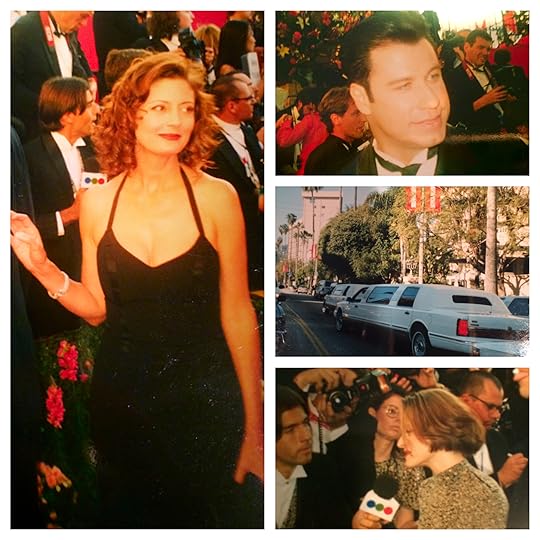
Clockwise: Susan Sarandon, John Travolta, limo traffic jam and Jodie Foster talks to the press

Steve Martin and press, Sharon Stone and Tom Hanks
It was fun discovering these old pictures in a cardboard box expertly marked PICTURES. I took them on a Kodak instant camera pre-internet. People didn’t share images the way they do now so I forgot about them.
1995 was a good year for movies. Forrest Gump. Four Weddings and a Funeral. Pulp Fiction. Quiz Show. The Shawshank Redemption. Nell. Little Women. Bullets Over Broadway. But Forrest Gump was the big winner. My husband Michael and I watched it all from The Shrine Auditorium, with David Letterman hosting. Wolfgang Puck outdid himself at The Governor’s Ball with pizza and a fabulous chocolate dessert and they gave out Forrest Gump boxes of chocolates at one of the after parties, which I brought home to Connecticut and kept until they attracted ants.
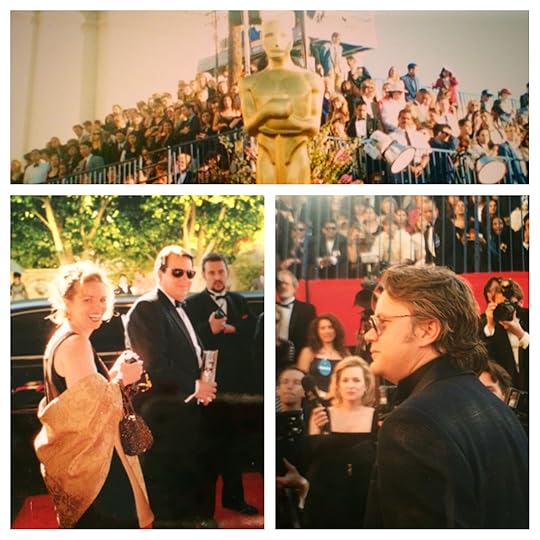
(top) Lovely Oscar, Tim Robbins and wanna-be celebs me and my husband Michael.
I think Susan Sarandon won hands down for most glam, though Sharon Stone in white satin was a close second and Jodie Foster was radiant in Armani. Tom Hanks passed the close up test and looked great, perhaps verifying that stars really do look better than the rest of us mere mortals (it took me three days and a painful pre-Spanx girdle to get ready.)
The following year Michael and I watched The Oscars from New York at the Entertainment Weekly party at Elaine’s with this sweet-as-can-be, gorgeous lady. I wolfed down my delicious dinner as I watched Christy eat exactly one half of hers.

Can’t wait for this week’s Oscars–they’re bound to be chock full of Hollywood glam once again. This time I’ll be watching in my pjs from my sofa. Heaven!
February 19, 2016
Holly Hollon’s best Lilac Girls map yet. This time Poland!
 I love Holly Hollon’s maps and how they bring the Lilac Girls world alive. This new one features my Polish main character Kasia’s hometown, Lublin, Poland. I spent some wonderful time in Lublin researching and this new map brings it all back in gorgeous color. Though many of the places on the map are fictitious, like Kasia’s “pink sliver of a house”, the Lublin movie theater and the book wall, many others are real–such as Grodzska Gate and imposing Lublin Castle. I love Holly’s details like Nadia’s orange door (and if you look closely you can see her dog Felka curled up on the stoop) the old time ambulance at Crown Court (this really was once the site of the Lublin Ambulance Corps) and the items stacked in the window of Z’s Pharmacy.
I love Holly Hollon’s maps and how they bring the Lilac Girls world alive. This new one features my Polish main character Kasia’s hometown, Lublin, Poland. I spent some wonderful time in Lublin researching and this new map brings it all back in gorgeous color. Though many of the places on the map are fictitious, like Kasia’s “pink sliver of a house”, the Lublin movie theater and the book wall, many others are real–such as Grodzska Gate and imposing Lublin Castle. I love Holly’s details like Nadia’s orange door (and if you look closely you can see her dog Felka curled up on the stoop) the old time ambulance at Crown Court (this really was once the site of the Lublin Ambulance Corps) and the items stacked in the window of Z’s Pharmacy.
So excited to add Holly’s latest to the group!



